Know the 2 carbon cycles and don’t confuse them.
Can we grow enough forests and use enough regenerative agriculture to sequester enough carbon to undo global warming?
To answer this question you have to understand the two carbon cycles. I’m simplifying, but you can think of two different cycles of carbon. One is the regular life cycle of carbon-based life forms. When something lives, it contains carbon, including trees, humans, and everything living in dirt and the oceans. When a plant or animal dies, it decomposes and its carbon returns to the rest of the environment. If you’ve read about the Amazon rain forest becoming a source of atmospheric carbon, that result illustrates this effect.
The other is the Earth’s pressure pushing life underground and turning it to oil. I’ll illustrate the two cycles.
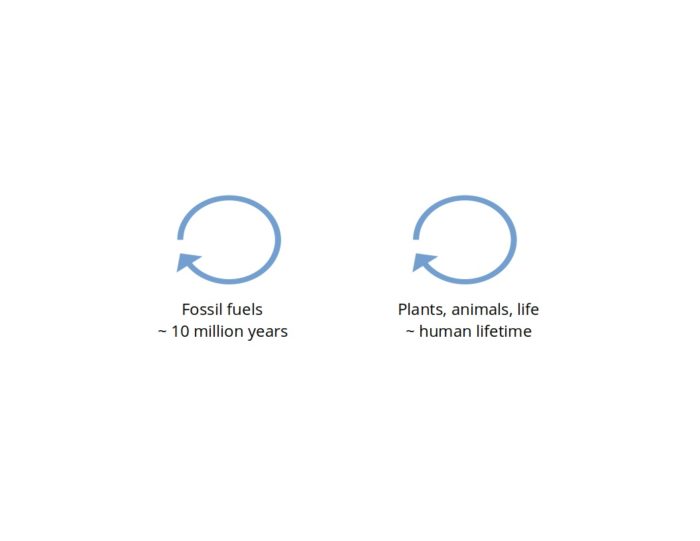
But this diagram misses that the cycles’ time scales are very different. The “regular life” cycle happens on century to shorter time scales. The fossil fuel cycle happens over tens of millions of years. Let me illustrate the different time scales:
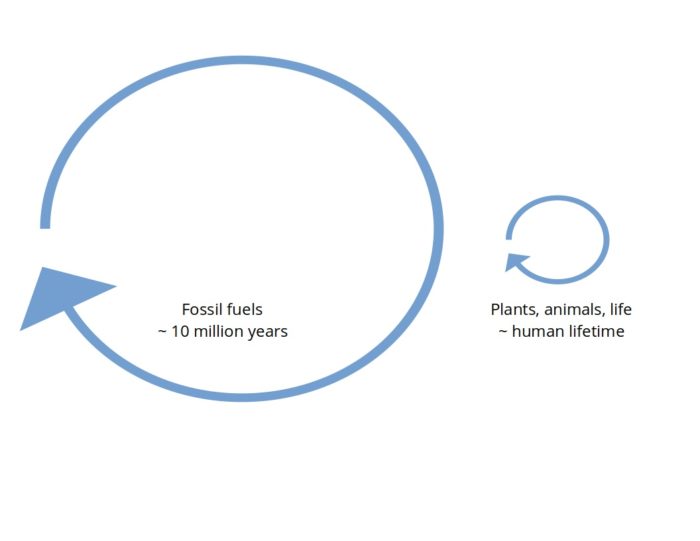
Now they don’t look the same, but the ratio isn’t a factor of five or ten. It’s much bigger. I’ll illustrate the difference once more, representing the different scales more.
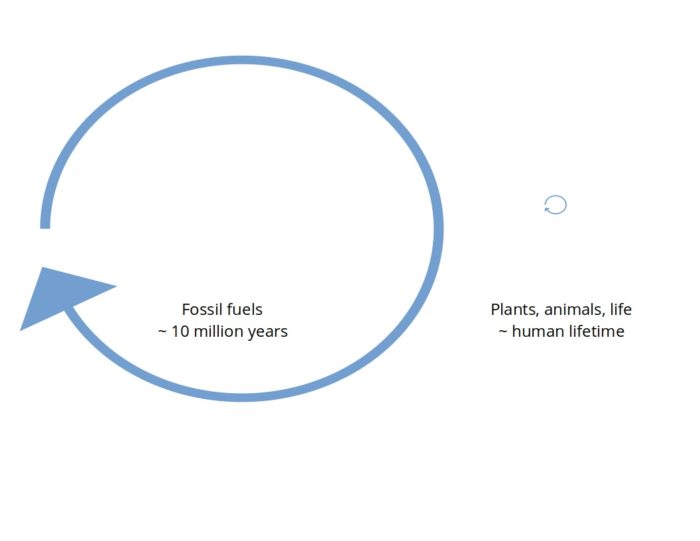
Even illustrating the difference, the ratios are nowhere near as close in life. Picture the left cycle so much bigger than the right that you only see the downward part on the right so it looks more like a straight line. I hope you can see what I mean here:
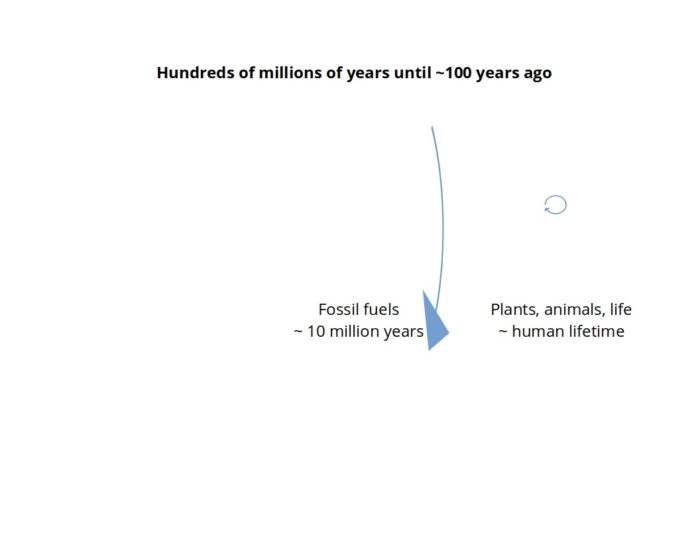
Our situation today
After hundreds of millions of years of carbon going into the ground, in the past hundred years, we’ve reversed it. We’re bringing carbon back out. Here’s our world now. If we want to sequester carbon, we have to lock it up in some way that it won’t return to the atmosphere in the timescale of a human life.
Sure, planting trees and regenerative agriculture will do something. In fact, it’s necessary to buy us time, but think of the huge swaths of oil we drilled from under Texas, Russia, and the middle east. Most of the trees we plant and soil we regenerate with restore the carbon emitted when our parents and grandparents cut down forests and overfarmed soil. Maybe we can grow more forest and other lifespan-timescale sequestering than existed in human existence, but we can’t guarantee it will stay there, nor will it match the extra carbon we’ve unleashed. We cut and burned forests before, we might again, especially during wars over resources, especially if we don’t lower our population, but we’re increasing it.
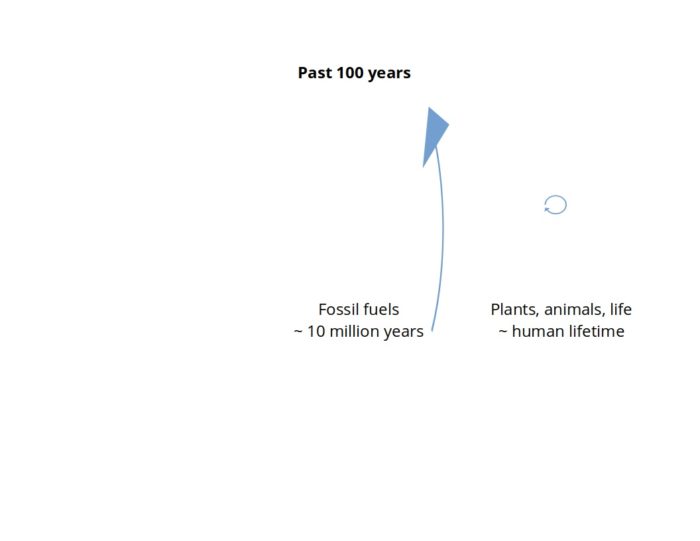
Who cares?
What’s the relevance? Burning fossil fuels reversed the left cycle. It puts carbon that was sequestered tens of millions of years ago into the air, warming the globe. Sequestering carbon with trees and soil doesn’t fix the problem for several reasons.
First, what carbon we sequester in the life cycle risks returning to the environment on human time scales. Re-sequestering carbon that had been locked up for tens of millions of years with something that will sequester it for decades won’t likely work for more than a few human generations. It’s necessary in the short term, but nearly pointless in the long-term.
Second, there are techniques to sequester carbon in rocks which could lock it up for geologic time scales—that is, over millions of years—but they’re nowhere near cost effective or scalable as ordering takeout and all the things that promote digging for more oil, reversing the left cycle. It’s also possible we could find ways to sequester long-term using life—maybe sinking trees under the ocean in a way they won’t decompose or otherwise release their carbon. In any case, none of these ways has been shown to work at a scale that would make a difference or at a cost we can afford. Other schemes require energy, but our problem now is that we’re low on energy after relying on fossil fuels. Energy we use to sequester carbon means energy we don’t get to use for the rest of the economy.
In other words, planting trees is important, but it doesn’t solve our problems. It buys us a little time.
If we don’t sequester carbon in a geological time scale
If we don’t sequester carbon in a geological time scale, we may not be able to reverse climate change in the lifetimes of people living today. I guess it’s possible to find a way to trap carbon in a way we can secure on geological time scales. Even if so, we aren’t close now. It’s safer to think of sequestering carbon as a scam. Then we’ll do more to stop digging for oil and more to find ways to sequester it on geological times scales.
The best we can do
The best we can do, I think, is to know that sequestering carbon is necessary, though not sufficient, and our best plan is to try, learn, and keep doing more—that is, to lead others. Research into sequestering carbon on geological time scales can help save civilization, but even more important is to stop drilling and burning fossil fuels as fast as possible. Leading others is the most effective way to stop emissions, which requires leading yourself first. Then you’re responsible for leading many people and will feel prepared to lead more.
I don’t see how we can do better than leaving oil and coal in the ground. If we’re lucky we’ll find people willing to lead us to reduce fossil fuel burning, which I’m trying to do, but people who pollute the most aren’t even willing to forego flying no matter how much I share that it improves life and more than ninety percent of people aren’t flying. And flying is a trivial change that makes a huge difference in one’s personal emissions.
I hope I get better at leading others so they feel some sense of personal responsibility and expectation of success to overcome their selfish entitlement and claims of powerlessness.
Read my weekly newsletter

On initiative, leadership, the environment, and burpees
Pingback: Want to live more sustainably: The measure that matters » Joshua Spodek
Pingback: My favorite posts » Joshua Spodek
Pingback: Challenge question (and answer): Could you pollute before fossil fuels? » Joshua Spodek
Pingback: You don’t think individual action works? How about any action at all? » Joshua Spodek
Pingback: Carbon offsets increase CO2 levels in the atmosphere. They do not decrease or offset them. They increase them. » Joshua Spodek
Pingback: How Environmentalists Fail (Where We Could Use Innovation) » Joshua Spodek
Pingback: Environmental leadership resources » Joshua Spodek
Pingback: This week’s selected media, July 27, 2025: Cool Food » Joshua Spodek
Pingback: Libertarians confused on pollution, sacrificing their core values. At the root: lack of hands-on practical experience. » Joshua Spodek
Pingback: Data on the two carbon cycles: Not even close » Joshua Spodek
Pingback: When not to worry about stranded assets, even to prefer them » Joshua Spodek